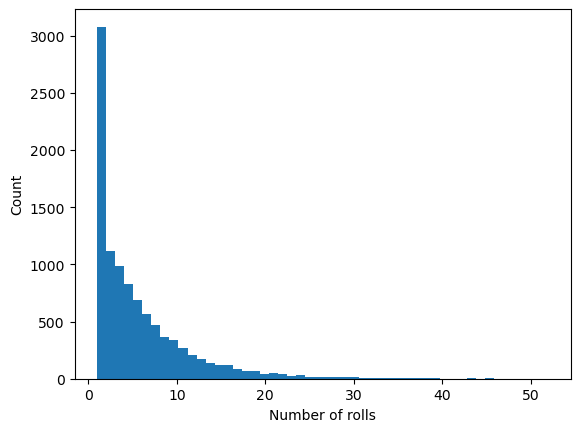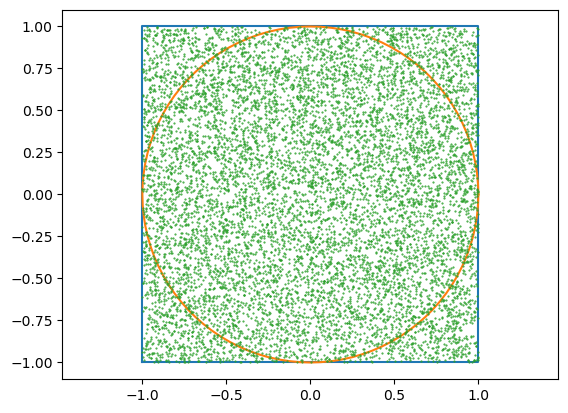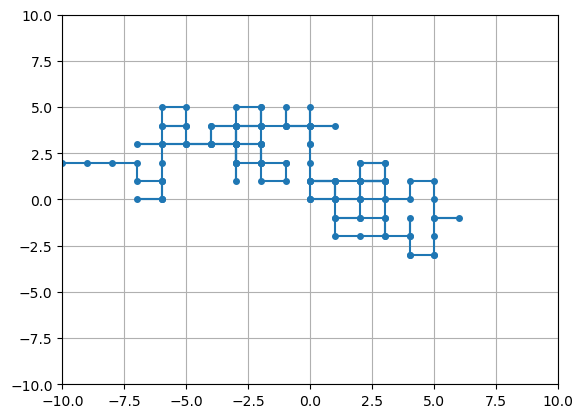5.3. Monte Carlo#
using PyPlot
using Random
5.3.1. Monte Carlo simulations#
A common technique to estimate probabilities and statistical quantities is Monte Carlo simulation. The computer runs many simulations that depend on random numbers and records the outcomes. The desired quantity can then be estimated by simple fractions.
As an example, the code below simulates rolling a die repeatedly until it rolls a 6, and recording the number of rolls that it took. The average number of rolls required can then be estimated.
ntrials = 10000 # Number of experiments
x = Int64[] # Array of outcomes
sumx = 0
for i = 1:ntrials
nrolls = 0
found_a_six = false
while !found_a_six
nrolls += 1
roll = rand(1:6)
if roll == 6
found_a_six = true
end
end
push!(x, nrolls)
sumx += nrolls
end
plt.hist(x, 50);
xlabel("Number of rolls")
ylabel("Count")
average = sumx / ntrials

5.9805
5.3.1.1. Card games, permutations#
To simulate card games, we need a way to represent the cards. There are 13 ranks and 4 suits, so we could simply use an integer between 1 and 52 and let 1 to 13 represent Ace, 2, 3, …, King of clubs, 14 to 26 all the diamonds, etc. We can use integer division and remainder to find the rank and suit:
function card_rank(card)
(card - 1) % 13 + 1
end
function card_suit(card)
(card - 1) ÷ 13 + 1
end
cards = 1:52 # All cards
[card_rank.(cards) card_suit.(cards)]
52×2 Matrix{Int64}:
1 1
2 1
3 1
4 1
5 1
6 1
7 1
8 1
9 1
10 1
11 1
12 1
13 1
⋮
2 4
3 4
4 4
5 4
6 4
7 4
8 4
9 4
10 4
11 4
12 4
13 4
We can now draw a random card by generating a random integer between 1 and 52. However, to deal e.g. a poker hand of 5 cards, we need to make sure we do not draw the same card twice. One way to do this is with Julia’s randperm(n) function, which generates a random permutation of the integers 1 up to n. We can use this to represent a shuffled deck of cards, and use the first 5 cards to deal a poker hand:
cards = randperm(52)
hand = cards[1:5]
[card_rank.(hand) card_suit.(hand)]
5×2 Matrix{Int64}:
4 1
1 3
11 1
3 4
10 3
5.3.1.2. Example: Probability of flush#
A flush means that all cards have the same suit. To estimate the probabilty that a random poker hand is a flush, we run Monte Carlo simulation:
ntrials = 100000
nflush = 0
for itrial = 1:ntrials
cards = randperm(52)
hand = cards[1:5]
suits = card_suit.(hand)
same_suit = true
for i = 2:5
if suits[i] ≠ suits[1]
same_suit = false
break
end
end
if same_suit
nflush += 1
end
end
approx_probability = nflush / ntrials
0.00205
This problem can also be solved using combinatorial techniques, which we can use to check the approximation:
exact_probability = 4 * binomial(13,5) / binomial(52,5)
0.0019807923169267707
5.3.2. Estimate \(\pi\) by throwing darts#
Random number can be used to approximate areas, or more generally, to estimate integrals. To illustrate this, consider a 2-by-2 square with a unit disk inside. Imagine throwing \(n\) darts on the square with equal probability everywhere. Then the fraction of darts that hit inside the circle should approximate the ratio between the areas, that is:
where the radius \(r=1\). This means we can estimate \(\pi\) as
n = 10000 # Number of darts
x = 2rand(n) .- 1 # Coordinates
y = 2rand(n) .- 1
plot([-1,1,1,-1,-1], [-1,-1,1,1,-1]) # Draw square
theta = 2π*(0:100)./100 # Draw circle
plot(cos.(theta), sin.(theta))
plot(x, y, linestyle="None", marker=".", markersize=1) # Plot dart points
axis("equal")
# Determine if points are inside the circle (a "hit")
hits = 0
for i = 1:n
if x[i]^2 + y[i]^2 ≤ 1
hits += 1
end
end
approx_pi = 4hits / n

3.1424
5.3.3. Example: Random walk#
A random walk can be described by the following algorithm:
Consider a 2-d array of square cells
Start at the center cell
At each turn, randomly choose a direction (up/down/left/right) and move to that neighboring cell
Continue until reaching an edge
function random_walk(n)
x = [0]
y = [0]
while abs(x[end]) < n && abs(y[end]) < n
if rand() < 0.5
if rand() < 0.5 # Up
push!(x, x[end])
push!(y, y[end] + 1)
else # Down
push!(x, x[end])
push!(y, y[end] - 1)
end
else
if rand() < 0.5 # Right
push!(x, x[end] + 1)
push!(y, y[end])
else # Left
push!(x, x[end] - 1)
push!(y, y[end])
end
end
end
x,y
end
random_walk (generic function with 1 method)
n = 10
x,y = random_walk(n)
plot(x, y, marker=".", markersize=8) # Draw dots at each point in x,y
grid(true)
axis([-n,n,-n,n]);


